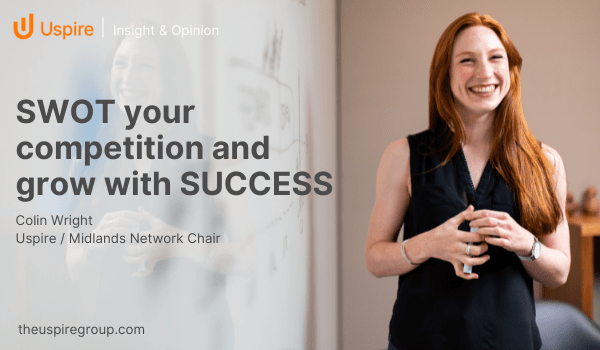In this blog we will continue to explore the ‘U’ for understand in the SUCCESS model.
As we conclude this section and consider all of the different components that will assist your strategic understanding of the market you serve and the capabilities of your business, two final well used tools that we promote in the Uspire Network strategic planning process are STEEPLE and the classic SWOT analysis which we refer to as the SWOT PLUS.
Gaining these additional and important insights before reviewing your strategic position ensures that your most valuable assets of cash and people are utilised in the most effective way. To optimise this return on investment you need to fully understand your customers changing requirements and the likely impact of external factors (like Covid 19 for example) on your business. Remember that virtually no product or service in todays rapidly changing markets is so unique that it cannot be quickly replicated or bettered on both price, quality and service. If however, you hold a focus group or ask your customers why they buy your product or service they will tell you that it’s because of price or a perceived benefit including product, quality and service? We expend significant energy and resources searching for this unique proposition that delivers a differentiated business. Simon Sinek referred to this realisation by stating that businesses exist on two distinct levels, manipulation and inspiration.
At Uspire Network we would add a third dimension which is anticipation we call this your AIM. How you target customer growth and your competition.
A nticipation
I nspiration
M anipulation
If we argue like Simon Sinek that most companies struggle to fully grasp why their customers are their customers or even why people are working for your organisation. Then the reality is that most businesses are making decisions or targeting a strategic position based on a set of incomplete or, more tragically, completely flawed assumptions about their core ideology and economic denominator. He argues that there are only two ways to influence human behaviour, you can manipulate it or you can inspire it, but at Uspire Network we believe that you can also anticipate it by understanding the broad range of factors that could influence it.
This particular blog is to remind you that some of the traditional but modernised models should be used or at least refreshed every year so that your strategic position anticipates change and you can improve the ‘U’ for understanding.
The STEEPLE is an excellent tool to help you fully comprehend the external factors that will impact the performance of your company. When significant changes occur it can be a useful process to assist you in anticipating new influences on your customer behaviour.
The best way to use it is as part of a strategic planning process with your senior team and brainstorm and gather key information that will help you populate the relevant sections.
Use the document based on the ‘4 seasons of Covid recovery’ but I would also recommend that you ask the team what is likely to change in the next 10 years in each of the sections. This prevents a narrow and closed ‘mind-set’ thinking that far out-stretches people’s imagination to the future possibilities.
Then challenge your existing direction based on these findings assess the relevance and role of your strategic anchor and create a detailed action plan.

Once you have completed your STEEPLE then you should consider both your internal and external SWOT analysis. Frustratingly we have been involved with many companies who always respond with ‘yes we use a SWOT’ but when you examine the output it usually resembles a quick brainstorm amongst the management team and a complete lack of rigorous questioning and evaluation of your macro and micro competitive environment. In building your forward plan it can be one of your most powerful tools and should be responsible for generating a large number of your strategic imperatives.
Once you are clear about your core ideology and your strategic anchor the SWOT process if used alongside the learnings from the STEEPLE and your Sun Tzu competitive positioning exercise becomes a decisive way of evolving and understanding your full business proposition including your critical defensive and offensive positions.
Strengths Need no explanation they are what you do well and often better than the competition they should be supported and evidenced by customer and employee feedback and testimonials.
Weaknesses These require patching in the short term but also fixing in a robust and sustainable way for the future. To do this properly your executive team must face the brutal facts and deal with any ‘elephants in the room’. It needs absolute honesty and realism to get any genuine strategic benefit from the exercise.
Opportunities It’s important in any process to find some ‘quick wins’ but the best strategic advantages will come from the information in your STEEPLE. What can you anticipate, inspire and manipulate in your macro and micro environment? How can you use a process like EPOCH which we discussed in a previous blog to move with great agility?

Threats This requires a detailed defensive plan and most of these risks will be determined by using the ‘10 dimensions of competitive positioning’ this exercise helps your executive team to anticipate where the enemies are coming from.

As mentioned earlier the SWOT is only effective if the questioning and facilitation of the process encourages ‘deep dive’ thinking and thorough analysis.
Here are the questions that underpin the Uspire SWOT PLUS methodology:-
Use these and the information from your STEEPLE and 10 Dimensions of competitive positioning to ensure that the quality of your SWOT guides your strategic objectives.
Answer questions whilst also considering your benchmark competitors.


These generic questions for each quadrant are to stimulate your thinking especially when used with the other tools but it is also important to build your own questions for each section based on your specific industry and market.
Once you have completed your analysis look at developing an action plan around the following SWOT PLUS matrix.
Make sure that when you develop your SWOT PLUS you also look for stretching and ambitious future objectives. Try to avoid the tendency to make the exercise fit your current state and existing strategic position. The finest commercial leaders do not allow a strategic planning process just to be a ticking box exercise. It is about identifying objectives and goals to grow and improve.

Now ask yourself three key questions from the SWOT PLUS exercise.
- What are my key insights from the process?
- What interdependencies exist that we have not considered that could hinder progress?
- So what are the critical actions for the next 100 days?

Once you have identified your key actions use the following template to provide additional structure to your strategic plan and this will aid the communication process. It also forms part of your measurement tools which will be included in a future blog and ‘Think Tank’ where we will explore the ‘S’ for STEER in the SUCCESS model.
When using the template give each goal a title and these headline descriptions should represent plans and objectives for the next 3 years. So think about them in the context of short, medium and long-term strategic imperatives.

Finally, we began with a few quotes from Simon Sinek so lets end on something from him that creates further context.
Creating your strategic plan and vision for the future with values people live and believe in and a sense of direction establishes the WHY for any business.
We call it the SUCCESS model for a reason because in his words there is an irony to success. Many people who achieve great success don’t always feel it. Some who achieve it talk about a loneliness that often goes with it. This is because success and achievement are not the same thing, yet all too often we mistake one for the other. Achievement is something you reach or attain like the goals and objectives. It is something tangible, clearly defined and measurable. Success, in contrast is a feeling, a state of being – you feel successful. While we can easily lay down a path to reach a goal, laying down a path to reach that intangible feeling of success is more elusive. Achievement comes where you pursue and attain the WHAT you want. SUCCESS comes when you are clear in the pursuit of WHY you want it. The former is motivated by tangible factors while the latter is more emotional, from a different part of the brain and we often lack the capacity to put those feelings into words. The finest commercial leaders have the ability to never lose sight of the WHY. They also ENERGISE us when they enable us to achieve our goals and PROVOKE us to stay focussed on the right direction and by doing this they truly INSPIRE us.

